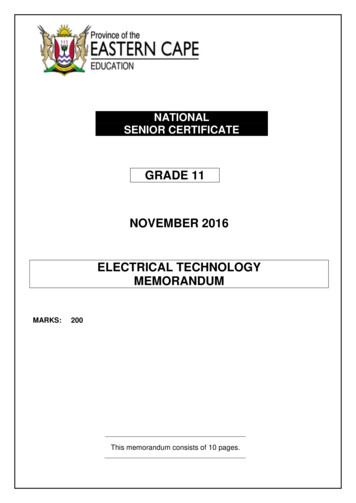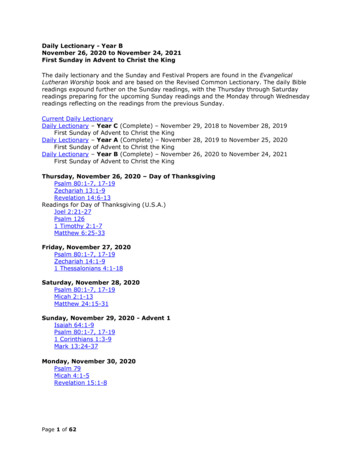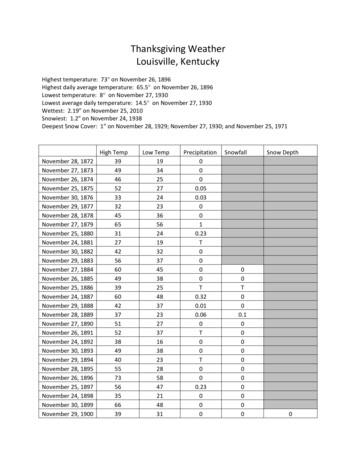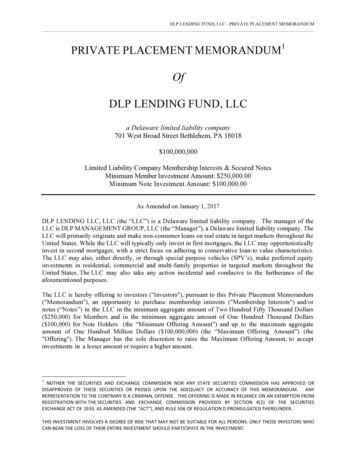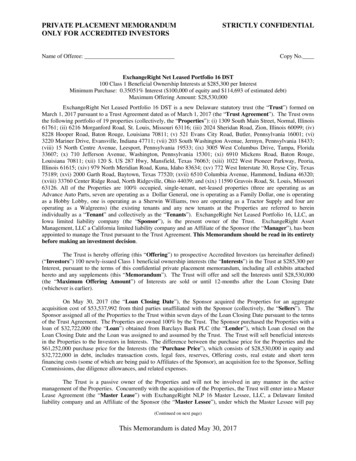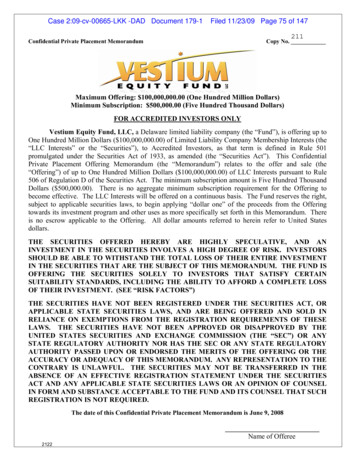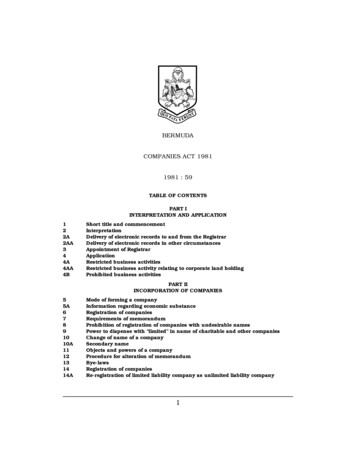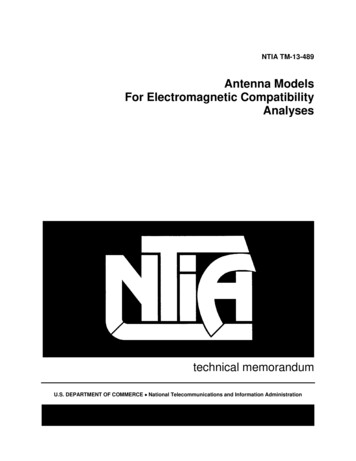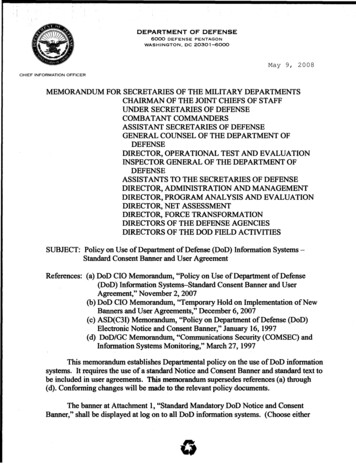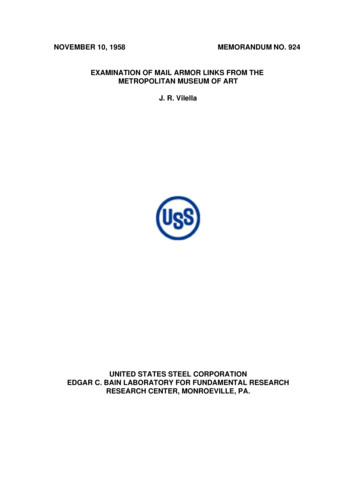
Transcription
NOVEMBER 10, 1958MEMORANDUM NO. 924EXAMINATION OF MAIL ARMOR LINKS FROM THEMETROPOLITAN MUSEUM OF ARTJ. R. VilellaUNITED STATES STEEL CORPORATIONEDGAR C. BAIN LABORATORY FOR FUNDAMENTAL RESEARCHRESEARCH CENTER, MONROEVILLE, PA.
Edgar C. Bain LaboratoryFor Fundamental ReasearchUnited States Steel CorporationResearch CenterMonroeville, PennsylvaniaNovember 10, 1958Memorandum No. 924Examination of Mail Amor LinksFrom the Metropolitan Museum of ArtJ. R. VilellaAbstractA number of solid links of mail armor were examined metallographicallyto determine if they had been made by stamping or by forge-welding. Although itwas not possible to locate the precise position of a single weld junction, and evidenceof deformation of the surface grain structure resulting from stamping would not bedetectable because of severe corrosion, it was concluded that the links were made bywelding on the basis of the occurrence of non-metallic inclusions in the form thatwould be normal in closed wire loops.Mail armor is sometimes built entirely of drawn wire links held closed bytriangular rivets, and sometimes of alternating rows of riveted and solid links. Itseems to be the consensus of experts in this field that the riveted links are made ofdrawn wire, and according to Dr. Stephen V. Granscay, Curator of Arms and Armorof the Metropolitan Museum of Art in New York City, at whose request thisinvestigation was undertaken and who submitted the links listed in Table I, “The markof the drawplate is clearly visible in the wire of the riveted links.” On the other hand,the method of making solid links has not been established.The purpose of this investigation is to seek an answer to the followingquestions asked by Dr. Granscay:(1) Were the solid links made by stamping or were they individuallywelded?(2) Are the links laminated?(3) Do the solid links show marks of the drawplate?
Standard metallographic procedure was used in theexamination of thelinks, they were individually mounted in bakelite, ground to approximately one half oftheir thickness, given a metallographic polish, etched with a suitable reagent andexamined microscopically at low and high magnifications.The evidence sought to decide if a solid link had been made by stampingwas the occurrence of a layer of deformed grains along the inner and outercircumference of the link. This would constitute valid proof of stamping, becausewhen a soft, ductile metal, such as the iron of which these links are made, is severedcold, it is inevitable that those grains which come in contact with the cutting edge willsuffer severe deformation. Figure 1 illustrates the deformation caused by punching ahole in a sheet of low carbon steel. It is true that deformation of the surface metal alsooccurs during wire drawing, if done cold, but if such deformed grains aresubsequently heated, as is necessary for welding, all traces of cold deformation areobliterated. The links illustrated in the accompanying photomicrographs, and othersnot photographed, were examined for traces of deformation of the metal at the surfaceand in no instance was satisfactory evidence found to justify the conclusion that thelinks was made by stamping. Unfortunately, these negative results do not, inthemselves, eliminate stamping as a possible method of manufacture, for the pittedcondition of the surface metal suggests that during their long existence these links hadcorroded severely enough to eat away all traces of the original surface metal.Moreover, if the links had been stamped and subsequently forged hot, any evidence ofcold work would be destroyed.The criterion employed to decide if a links had been made by welding wasthe presence of certain discontinuities in the structure of the metal which can beexpected to occure in the vicinity of the junction as a result of welding. Among suchdiscontinuities, those most often met are (1) localized, marked grain growth; (2)evidence of melting, or of incipient melting; (3) more or less continuous line of oxideinclusions, or of voids, normal to the direction of drawing. Figures 2 and 3 illustratetwo of these discontinuities in a modern pressure weld, which is the closestapproximation to a blacksmith weld that was available. Unfortunately, no linksdisclosed evidence that could be construed as valid proof of welding. Some links didexhibit decided differences in grain size from area to area, but these were scattered at
random and often their shape and size did not convey the impression of being theresult of welding. The nearest approximation to the type of grain growth oftenobserved near a weld junction is illustrated at the top and bottom of Figure 4.However, although suggestive of welding, this is not sufficient evidence to warrant acategorical statement.While it has not been possible to prove by positive identification of a weldjunction that the links were closed by some form of welding, it is the writer's beliefthat welding was the only method of manufacture employed. This belief is based onthe following observations.(1) The stringers of non-metallic inclusions curve with the link as isclearly shown in Fugures 5 and 6. Had the links been stamped from a flat sheet, theinclusions would occur in straight lines, as illustrated in the sketch, Figure 7A. Thefact that they occur as shown in Fugure 7B is strong evidence that the metal wasdrawn into wire before it was closed to form a link.(2) Examination of several riveted links showed that their non-metallicinclusions also curved with the links, confirming the assumption that theriveted links were made of drawn wire, and strengthening the belief that the solidlinks had also been made from similar wires.(3) It seems reasonable to assume that had the solid links been stampedfrom a flat sheet, the surfaces corresponding to the top and bottom of the sheet wouldtend to be somewhat flatter than the corresponding surfaces in the riveted links. Suchhas not been observed to be the case. On the average all the links appear to be equallyround. However, the possibility that the armorer may have known how to stampround, wire-like links from a flat sheet cannot be ignored. Figure 10 shows thesimilar degree of roundness of the wire in a riveted and a solid link from the sameshirt of mail.Figure 11 illustrates the micrstructure of link number 29-150-9V andFigures 12 and 13 that of link number 14-25-1555. These links differ radically fromall others in two respects; they contain more carbon than the average link and theywere probably water quenched. The grey, finely divided areas shown in thephotomicrograph of link number 29-150-9V (Fig. 11) were identified as martensite, aconstituent of steel of great hardness and obtainable in an unalloyed steel containing
an appreciable amount of carbon by very rapid colling, such as water quenching. It isestimated that this link was quenched from a temperature in the vicinity of 1400 F.The structure of link number 14-25-1555 (Figs. 12 and 13) also indicates aconsiderable amount of carbon and a rapid quench, bu inaddition this link wastempered at some temperature that is not possible to estimate. Because these linkscontain an appreciable amount of carbon and were cooled rapidly they are muchharder than the other links. See Table II.The question whether or not a link is laminated is of relatively littlesignificance but difficult to answer. If the metal contains a considerable amount ofstringers of non-metallic material (probably occluded slag) it may be said to belaminated; if the non-metallic inclusions are fewer, shorter, and well scattered, themetal does not appear laminated. It is difficult to draw a dividing line. Some of thelinks examined showed considerable occluded slag, others much less, as may be seenby comparing Figures 14 and 15 with Figures 5 and 6 and Figures 8 and 9. Largeareas of the irons illustrated in Figures 14 and 15 are “clean” (free from non-metallicinclusions) even when judged by modern standards.Figure 16 was obtained from link No. 27.183.14 and shows a group ofNeumann bands. This structure, also referred to as “mechanical twins” is generallyassociated with a metal that has been subjected to severe impact or to deformation atrelatively low temperatures. It is most likely that these bands were made by thearmorer while cold-hammering the metal but it is also possible that they wereproduced by a healthy blow in battle, or in handling.Several riveted links and all the solid links were examined with a lowpower microscope for marks of the drawplate. None that could be positivelyidentified was detected, but it may well be that although present they were notrecognized or that they had been removed by corrosion of the surface.*NOTE - FIGURES 14, 15 & 16 WERE LEFT OUT DUE TO THE PICTURES BEING TOO PALETO SHOW ANY DETAIL.
Summary and Conclusions(1) Detailed macro- and microscopic examination of the solid linkssubmitted by the Metropolitan Museum of Art failed to disclose a recognizable weldor evidence of deformation of the surface metal associated with stamping.(2) The fact that the non-metallic inclusions in the solid links are stretchedout and curved as they would be in a loop of wire, is considered conclusive evidencethat the solid links were closed by welding.
Table IChain Mail Specimens SubmittedDesignationDescription27.183.14Brayette. German, about 1525Solid and riveted links (riveted, flat wire; solid, half roundwire)29.150.9VShirt of mail. German, about 1500Solid and riveted links (solid link, half round; riveted link,flat)14.25.1568Shirt of mail. German, about 1500Solid and riveted links (riveted, flat wire; solid, half round)14.25.1555Shirt of mail. German, about 1525Solid and riveted links (riveted, flat wire; solid, half round)54.46.2Shirt of mail. German, about 1525Riveted links (flat wire)25.188.9Shirt of mail. German, about 1550Riveted links (flat wire)29.158.176Shirt of mail. German, about 1575Riveted link (round wire)27.237Shirt of mail. German, about 1575Riveted link (round wire)14.25.1539Cape of mail. German, about 1575Riveted link (round wire)36.25.33Shirt of mail. Turkish, 17th CenturySolid link and double riveted link(Flate wire in both cases)14.99.28Shirt of mail. Turkish, 17th CenturySolid and riveted links (moulded section)14.25.1562Shirt of mail. Persian, 18th CenturySolid and riveted links (round wire)36.25.476Shirt of mail. Persian, 18th CenturyAll riveted links (round wire)CoifRare XIV Century European Headpiece
Table IIDPH Hardness - 100 Gm. load(Arranged in order of increasing hardness)Link 6Walters 9V35514-25-1555468* Average of at least three readings.RemarksRiveted - near rivetRiveted - opposite rivetContains Sheroidal carbidesSolid LinkPartly martensiticHigh carbon - Tempered martensiteFIG. 1 -- DARK CURVED BAND SHOWS DEFORMATION OFGRAIN STRUCTURE IN LOW CARBON STEEL ALONG EDGEOF HOLE PUNCHED IN SHEET. PICRAL ETCHED - X200
FIG. 2 -- WELD JUNCTION IN MODERN PRESSURE WELDEDPIPE - ETCHED WITH 25% NaHSo 3 - X30
FIG. 3 -- SAME WELD AT HIGHER MAGNIFICATION. NOTEOXIDE GLOBULES INDICATING JUNCTION. LIGHT PICRALETCHED - X200
FIG. 4 -- SOLID LINK, 27-183-14, X 13 GERMAN-BRAYETTE,ABOUT 1525.
FIG. 5 -- SOLID LINKS - 14-25-1568, NITAL ETCH - X100GERMAN SHIRT OF MAIL, ABOUT 1500FIG. 6 -- SOLID LINK - COIFNITAL ETCH - X100
FIG. 7A - OCCURRENCE OF NON-METALLIC INCLUSIONSEXPECTED IN STAMPED LINKFIG. 7B - OCCURRENCE OF NON-METALLIC INCLUSIONSEXPECTED IN WELDED WIRE LINK
FIG. 8 -- RIVETED LINK - 14-25-1568GERMAN SHIRT OF MAIL, ABOUT 1500X50FIG. 9 -- RIVETED LINK - 27-183-14GERMAN BRAYETTE, ABOUT 1525X50
FIG. 10 -- RIVETED AND SOLID LINKSX5PERSIAN SHIRT OF MAIL, 18TH. CENTURY 14-25-1562FIG. 11 -- SOLID LINK 29-150-9V PICRAL ETCHED X100GERMAN SHIRT OF MAIL, ABOUT 1500
FIG. 12 -- SOLID LINK 14-25-1555 PICRAL ETCHED X100GERMAN SHIRT OF MAIL, ABOUT 1525FIG. 13 -- SAME AS ABOVEX2000
light picral etched - x200. fig. 4 -- solid link, 27-183-14, x 13 german-brayette, about 1525. fig. 5 -- solid links - 14-25-1568, nital etch - x100 german shirt of mail, about 1500 fig. 6 -- solid link - coif nital etch

